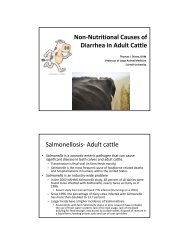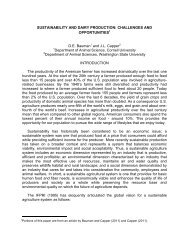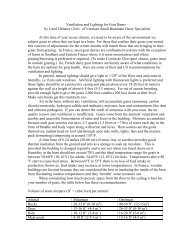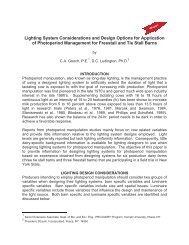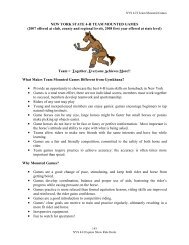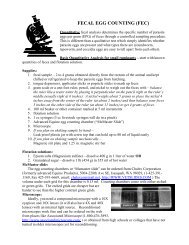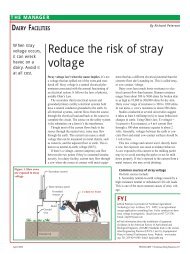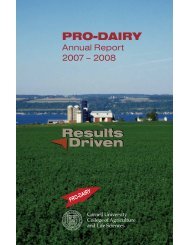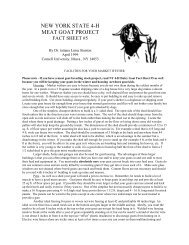1 GOAT SEMEN COLLECTION AND PROCESSING BY DR. LOUIS ...
1 GOAT SEMEN COLLECTION AND PROCESSING BY DR. LOUIS ...
1 GOAT SEMEN COLLECTION AND PROCESSING BY DR. LOUIS ...
Create successful ePaper yourself
Turn your PDF publications into a flip-book with our unique Google optimized e-Paper software.
INTRODUCTION<br />
<strong>GOAT</strong> <strong>SEMEN</strong> <strong>COLLECTION</strong> <strong>AND</strong> <strong>PROCESSING</strong><br />
<strong>BY</strong><br />
<strong>DR</strong>. <strong>LOUIS</strong> C. NUTI<br />
The object of this manual is to bring together the goat semen collection and processing<br />
techniques that are available for use by the Artificial Insemination (AI) industry. Its purpose is to<br />
provide a reference source of operation techniques that will help semen production staff establish<br />
and/ or improve semen quality and quantity.<br />
It is important to remember that there are many different techniques which will give<br />
satisfactory semen quality for AI, but not all will give maximum reproduction efficiency. Not all<br />
semen processors are in agreement as to what is the best technique to use. What "works" in their<br />
hands may be the result of biological variations in the buck and even in environmental and<br />
management conditions at the point of collection.<br />
There are many factors that will contribute to successful semen collection and processing<br />
techniques including nutrition, animal housing, processor training, etc. These subjects will be dealt<br />
with to a limited degree in the text. Other subjects such as reproductive physiology are covered<br />
briefly, and the readers are referred to other manuals and books on the subject listed under<br />
Recommended Readings.<br />
I. Semen Production and Collection<br />
A. The Development of the Sperm Producing System<br />
The onset of the production of spermatozoa represent only the final step in a series of<br />
complex changes that govern their number and properties. These events start prenatally when the<br />
primordial germ cells migrate from the germinal crest and come to lie in the presumptive gonads<br />
1
sometime before sexual differentiation. In the fetus and young male, the gonocytes are contained<br />
inside the seminiferous tubules. These multiply and after birth give spermatogonia. The quantitative<br />
efficiency of spermatogenesis depends to a great extent in the manner in which these divisions take<br />
place. The cells originating from the last spermatogonial division are the primary spermatocytes.<br />
Meiotic division of these result in the production of daughter cells, the secondary spermatocytes.<br />
The secondary spermatocytes divide and form spermatids which undergo a complex series of<br />
changes (spermiogenesis) resulting in the spermatozoa. The quality of the spermatozoa produced<br />
depends to a great extent on this complex metamorphosis which occurs in the seminiferous<br />
epithelium but undergoes completion in the epididymis. The various germ cells are located in the<br />
seminiferous epithelium, whose structure is maintained by the Sertoli (nurse) cells (see Figs. 1 and<br />
2). The two major functions of the testis include androgen synthesis by the interstitial cells (Leydig)<br />
and sperm production within the seminiferous tubules. Although these two functions are separated<br />
anatomically, intercellular communications exist between them.<br />
FIGURE 1: Hypothalamus<br />
2
The postnatal development of the male reproductive tract has received some attention,<br />
primarily in the bull and ram. Puberty is commonly defined as being the point in time when the male<br />
first produces sufficient sperm to impregnate a female. In many of the domestic species it is<br />
practically defined when an ejaculate is obtained containing 50 million sperm of which 10% are<br />
motile. The pubertal period is associated with rapid testicular growth, changes in LH secretory<br />
pattern, a gradual increase in blood testosterone, and the initiation of spermatogenesis. The<br />
hypothalamus is believed to play a key role in initiating puberty because the pituitary gland, gonads,<br />
and steroid-dependent target tissues are each competent and ready to respond to their respective<br />
tropic hormones prior to puberty. In the boar, bull and ram, and probably the buck, puberty appears<br />
to be the culmination of a continuous and lengthy process of endocrine changes which begin shortly<br />
after birth. The most remarkable early change is an increase in the frequency of pulsatile discharge<br />
of LH. This is followed by altered testicular steroidogenesis, increased circulating levels of<br />
testosterone, differentiation of Sertoli cells and the onset of spermatogenesis.<br />
It has been proposed that puberty occurs when an animal becomes desensitized to the<br />
feedback inhibition imposed on the hypothalamic-pituitary complex by gonadal steroids.<br />
Presumably, the allows an increase in GnRH discharge and a greater response by the pituitary gland<br />
to GnRH.<br />
Spermatogenic Cycle<br />
The spermatogenic cycle begins with a stem cell or A-type spermatogonia, which provides<br />
the starting point of a spermatogenic series. The duration of spermatogenesis, that is from the time it<br />
takes an A-type spermatogia to end up as spermatozoa in the buck is probably very similar to what<br />
has been reported for rams, namely 47 days.<br />
3
The impuberal testis is under pituitary control. The multiplication and differentiation of<br />
supporting cells are gonadotropin dependent. In lambs, the testis weight and the number of<br />
supporting cells which decrease after hypophysectomy are maintained after injection of LH. FSH<br />
has a synergistic action with LH. Testosterone is ineffective. The mitotic activity of the gonocytes is<br />
more pituitary independent but differentiation into spermatogonia, giving rise to spermatogenic<br />
activity with the subsequent appearance of the primary spermatocytes, is under the influence of<br />
pituitary gonadotropins. In adult rams (and probably bucks) LH, FSH and prolactin are secreted in<br />
pulsatile patterns with peaks of testosterone secretion following 30 to 60 minutes after each plasma<br />
LH peak.<br />
Onset of sperm crop production in bucks is apparently breed dependent. It is known that<br />
sperm cells begin to be produced in high concentrations (2 x 10 9 /ml) in 1.0 ml ejaculates with very<br />
good wave motion in Alpine bucks at 4 to 8 months of age, at 7 to 9 months in Boer goat bucks and<br />
considerably later in the Damascus breed.<br />
B. Semen Collection Technique<br />
The methods commonly used for collection of ram and buck semen are the artificial vagina<br />
(AV) and the electroejaculator (EE). The most commonly used and easiest procedure is the use of<br />
the AV. The AV method is painless, quicker and does not stress the animal at all. The AV resembles<br />
a car radiator hose and is about six inches in length. It has an inner rubber liner (containing water at<br />
a temperature of 100°F) placed between the liner and the hose. The warmer water simulates the<br />
vagina of a doe. A latex rubber collection cone is placed in the AV and a graduated collection tube<br />
is placed on the end of the cone.<br />
The buck is collected for semen evaluation or processing by allowing him to mount a doe in<br />
4
heat, another buck, or a wether. The usual procedure is to use a teaser doe that is in heat. This can<br />
be a natural heat or one induced by a prostaglandin product. A doe in heat usually stands better for a<br />
buck than a wether or another buck. She emits a smell when in heat that causes the buck to give a<br />
better ejaculate. The doe is usually tied or held and the buck allowed to go through his courting<br />
behavior. The buck is allowed a few false mounts, then the person with the AV collects the ejaculate<br />
by directing the penis into the AV. The test tube containing the ejaculate should be protected from<br />
direct sunlight and cold temperatures.<br />
Electroejaculators come in a variety of shapes and sizes and are used when animals are not<br />
trained for AV collection, are physically unable to mount, or a suitable mount is not available. Most<br />
workers have obtained a greater volume of semen but of lower concentration of spermatozoa with<br />
EE that with an AV. Some animals do not respond well to the electrical stimulus, especially if a<br />
second or third collection is desired. Further, there is some danger of contamination of the semen<br />
sample with urine. Greater concentrations of sodium and potassium were found in both the sperm<br />
and seminal plasma obtained by EE. The increased volume of seminal plasma obtained by EE<br />
appears to reduce the resistance of sperm to cold shock and decreases the post-thaw survival rate of<br />
frozen semen.<br />
Limited comparisons of fertility showed that the conception rate at first service was 17%<br />
higher when semen was collected with an AV. However, other reports have not found a significant<br />
difference in fertility with semen collected by these two different methods. Recent advances in the<br />
anatomical and physiological knowledge of the male reproductive tract may lead to EE techniques<br />
which permit acquisition of normal sperm to seminal plasma ratios in the ejaculate.<br />
II. Factors Influencing the Output of Sperm<br />
5
In addition to the role the method of collection plays as discussed above, there are a number<br />
of other factors which influences the size and sperm content of the ejaculate.<br />
A. Seasonal Factors<br />
In bucks and rams, changes in day length influenced testicular activity by modifying the<br />
release of GnRH and thus the gonadotropins. In seasonal breeders, the volume of the ejaculate is<br />
high in the breeding season and decreases in the non-breeding season (Fig. 20). Sperm concentration<br />
follows an opposite trend. However, no seasonal variations in total sperm numbers per ejaculate are<br />
reported. When the volume increases or decreases, the changes of volume are mainly due to changes<br />
in quantities of fluids secreted by the accessory glands and the epididymis which are androgen<br />
dependent. The androgen receptors in target organs need a preliminary preparation in which<br />
prolactin has been implicated. In turn, prolactin secretion is associated with daily photoperiod of<br />
long duration (i.e., spring and summer days at northern latitudes). The latter knowledge was brought<br />
about by studies in rat and sheep, but may well apply to the male goat in which blood plasma<br />
prolactin levels rise in the spring to culminate in summer and drastically decline in the fall, while the<br />
androgen abruptly rise takes place in the middle of the Summer to culminate in the Fall and decline<br />
in the middle of winter.<br />
Figure 20. Seasonal Variations in Volume and Sperm Concentration of Ejaculates<br />
(m ± sd).<br />
6
B. Age, Breed, and Within Breed Differences<br />
As in other species of livestock, there are breed differences with respect to age of puberty,<br />
ejaculate volumes, sperm concentrations, and total sperm per ejaculate. In early maturing breeds<br />
such as the Alpine, sperm numbers per ejaculate in the first breeding season represent only 60% of<br />
those collected in the second breeding year, which are characteristic of adult sperm production<br />
capabilities (Graph 3). In addition to semen production between breeds, there are differences also<br />
observed in the amount of sperm ejaculated by animals of the same age and breed. Animals may be<br />
classified and ranked for breeding replacement potential early after puberty (i.e., mean of 15<br />
ejaculates over an eight week period). The resulting ranking appears to remain the same in the first<br />
few breeding seasons (Graph 4).<br />
Delayed puberty can be the result of breed, within-breed genetics, poor pre-pubertal<br />
nutrition, diseases, parasitism, month of birth, and injury. Animals not producing high quality semen<br />
7
y the time they are 12 months of age become a concern and should be considered candidates for<br />
culling.<br />
Old age arrives in bucks at different ages, depending on health, environment, and use. Most<br />
animals of 8 to 10 years of age appear to have adequate sperm numbers but an increase in<br />
abnormalities. The best prediction of how long a buck will live and produce good viable semen,<br />
while not 100% accurate, is to evaluate blood lines. This requires, of course, many individual<br />
observations within each group. With the onset of old age, there are bucks who have episodes of<br />
excellent semen production which lasts a period of weeks and then goes into another period of poor<br />
quality semen from which he may or may not recover. The reason for these episodes are unknown<br />
and difficult to predict.<br />
C. Unknown Factors Influencing Sperm Output<br />
The amount of good quality semen is decreased by hyperthermia associated with high<br />
ambient temperatures with high relative humidity or fever. Low levels of energy intake, poor quality<br />
forage and lack of particular nutrients all contribute to poor ejaculate quality. Precise knowledge as<br />
to the most practical semen collection frequency to obtain optimal sperm quality and quantity is<br />
lacking. Most processors and buck stud operators work on an individual by individual basis.<br />
GRAPH 3: TOTAL NUMBERS OF SPERMATOZOA ...<br />
8
GRAPH 4: MALE <strong>GOAT</strong>S OF TWO BREEDS RANKED ACCORDING TO SPERM<br />
PRODUCTION<br />
9
The resorption of sperm is weak in the epididymis with most loss occurring in the urine or by<br />
masturbation. The epididymal sperm reserves available daily for ejaculation are readily depleted<br />
with approximately 62% of the potential daily sperm collection being obtained in the first two<br />
ejaculates. Epididymal replenishment is fairly rapid and collections twice per day at 24 hr intervals<br />
have been practiced in well-managed facilities. In adult Alpine males ejaculated once per day during<br />
the breeding season, weekly production of up to 25 billion spermatozoa per animal have been<br />
attained.<br />
Even with our ability to supposedly package enough viable and morphologically normal cells<br />
in a straw or ampule, there remains factors of semen that contribute to fertility (or lack thereof) that<br />
are not well understood. It has been found in many bull studs that bulls with high semen quality<br />
credentials give lower than desirable fertility. Conversely, some ejaculations of "apparent" poor<br />
visual quality readily settle animals. These unknowns might range from subtle differences in the<br />
DNA makeup to handling and inseminating interacting with the semen available. Recent<br />
development of tests to evaluate the integrity of the internal nucleic acid component may shed light<br />
on fertility availability.<br />
Subjective evaluation of semen has been the one method commonly used out of necessity,<br />
because no other alternatives were available. Unfortunately, this approach is often prone to observer<br />
bias and error. To eliminate this bias, a number of computerized semen analyzers have recently been<br />
introduced onto the market. Any system of this type must rely on image size, shape, and/or grey<br />
scale characteristics to distinguish individual spermatozoa and differentiate them from debris that<br />
may be present in the field of view. Such discrimination is not 100% accurate. Even if a system<br />
were very accurate and precise in its tracking and detection, the objective data obtained might not be<br />
10
predictive of sperm fertility. However, these systems have evolved to the point where reliable,<br />
accurate data systems have evolved to the point where reliable, accurate data on cell counts,<br />
concentrations, number of motile cells, % motility, mean linearity, straight line velocity, curvilinear<br />
velocity, and lateral head displacement can be generated (Fig. 5). Also, some systems are able to<br />
track and plot individual sperm cells for several seconds (Fig. 6). It is now possible to determine the<br />
effects of processing treatments on these parameters. Coupling this "high technology" assessment<br />
of semen quality, with a bioassay assessing fertility, would greatly strengthen the assessment of a<br />
buck's reproductive value. Such a bioassay may be the use of the zona-free hamster ova penetration<br />
test developed by Yanagimachii in 1976. He found that capacitated human sperm cells were capable<br />
of penetrating hamster vitellin (zona-free ova) by removing the zona pellucidae and that the fertility<br />
of the male was correlated with the level of penetration.<br />
AUTOMATED <strong>SEMEN</strong> ANALYSIS REPORT<br />
11
FIGURE 6: <strong>GOAT</strong> SPERM SWIMMING PATTERNS: 10 SECONDS DURATION<br />
12
III. Sperm Cell Preservation<br />
Spermatozoa, by nature, are catabolic cells. This means that in the metabolic processes they<br />
deteriorate as they use stored energy. With time, they age and slowly die off until all cells are<br />
immotile and incapable of fertilization. Likewise, semen subjected to adverse environments will<br />
irreversibly deteriorate and become useless. Because sperm have little or no anabolic or healing<br />
capacity, anybody working with any stage of semen processing must be attuned to the potentially<br />
harmful environments in which semen is placed. The main objective in semen processing is to<br />
minimize the catabolism of semen so that the quality of thawed semen is similar to that which was<br />
originally ejaculated. By doing this, semen can be packaged so that more than the minimum<br />
threshold number of viable cells are available in the oviducts.<br />
There are almost as many suggested freezing procedures and extender formulations as there<br />
are researchers studying AI in goats. The long list of extenders include nearly every imaginable kind<br />
13
of medium from cow's milk, to coconut milk, to tomato juice, to various exotic mineral waters. I<br />
will only discuss a few extenders, the relative importance of these components, and some<br />
controversial ideas about semen preservation. Areas of importance that can contribute to how well<br />
semen survives processing and thawing are length of holding time at warm (room) temperatures after<br />
collection, cooling rates to 35°F eventually to -320°F; extender composition, antibiotics used, and<br />
method of thawing. These factors act individually or interact with each other. To find the current<br />
balance of conditions under varied laboratory and/or field conditions to reach our desired quality<br />
levels is the challenge for every processor.<br />
A. Liquid Stored Semen<br />
Generally, when semen is extended and stored above 0°C, sperm cell survival is of a few<br />
days duration and sperm fertilizing ability cannot be preserved for more than a few days. Sperm cell<br />
survival is generally longer than fertilizing capacity and the former cannot be used as an indication<br />
of the latter.<br />
B. Long-Term Storage<br />
Most, if not all, semen is preserved in a frozen state. In order to accomplish this goal,<br />
suitable extenders must be used. An ideal extender has to meet certain requirements: a) provide<br />
nutrients as a source of energy; b) contain constituents that provide protection against the harmful<br />
effects of cooling and freezing; c) provide a buffer to prevent shifts in pH as lactic acid is formed; d)<br />
maintain the proper osmotic pressure and electrolyte balance, e) contain antibiotics that inhibit<br />
bacterial growth, f) substantially increase the volume of semen so that multiple inseminations can be<br />
performed; and g) provide an environment in which metabolic activities of the sperm can continue.<br />
Most extenders for liquid or frozen semen have been either egg yolk or milk or a<br />
14
combination of the two as a basic ingredient. The primary benefit derived from fresh egg yolk is<br />
protection of the sperm cell against cold shock by yolk lipoprotein and lecithin. The milk protein,<br />
casein, has been established as the agent responsible for prevention of cold shock.<br />
Milk Extenders<br />
Goat semen has been diluted in saline, sodium citrate or skim milk. Of these extenders, only<br />
skim milk heated at 95°C for 10 minutes satisfactorily preserved the fertilizing capacity of goat<br />
spermatozoa.<br />
Cow's milk has been used as an extender in routine artificial insemination of goats with good<br />
fertility results. A skim milk glucose-glycerol extender has also been used to freeze goat semen.<br />
Egg Yolk Extenders<br />
There are two schools of thought regarding the use of egg yolk as a component of a goat<br />
semen extender. Semen diluted with egg yolk has resulted in acceptable conception rates for some<br />
workers. In 1,007 goats inseminated with sodium citrate glucose-yolk-glycerol extended semen,<br />
conception rates were 60 and 92% with frozen thawed and fresh semen, respectively.<br />
Other investigators believe that egg yolk is toxic to the goat spermatozoa. An enzyme<br />
(phosphotidase) produced by the bulbo-urethral glands of the male goat catalyses the hydrolysis of<br />
lecithins in egg yolk to fatty acids and lysolecithins, which are toxic to the spermatozoa. The<br />
presence of phosphotidase in the seminal plasma of the goat means that media containing egg yolk<br />
cannot be used for semen extension.<br />
Seminal plasma has been blamed as a limiting factor of goat semen freezability and fertility.<br />
Washing goat spermatozoa in a physiological solution improved the percentage of motile sperm in<br />
fresh ejaculates. Post-thaw motility of spermatozoa was also increased.<br />
15
Semen Extension Rate<br />
The objective of extending semen is to provide an appropriate volume of inseminate with a<br />
sufficient number of sperm to give high fertility without wasting sperm.<br />
Sperm concentration of the ejaculate varies from 2 to 6.5 x 10 9 sperm/ml. Highest fertility in<br />
ewes was reported for sperm suspension frozen at a concentration of 666 x 10 6 sperm/ml. Another<br />
worker inseminated goats with 1 x 10 9 sperm/ml and reported fertility.<br />
Semen of rams and bucks is routinely extended immediately after collection at 37°C and<br />
cooled slowly to prevent cold shock, resulting in sperm damage. Lipoprotein and lecithins, found in<br />
egg yolk, and milk, provide protection from cold shock when added to the semen before cooling.<br />
The optimum cooling rate is one that prevents cold shock but is fast enough to maintain healthy,<br />
viable sperm cells. After extension, semen is cooled at 5°C at approximately 0.5°C/min.<br />
Glycerol is added to extenders to protect sperm against the detrimental effects of freezing. It<br />
has been suggested that the increase in intracellular salt concentration due to the removal of water<br />
from the cell during ice formation is a major cause of sperm damage during freezing.<br />
The protective action of cryo-protectants, such as glycerol is largely attributed to their salt<br />
"buffering" capacity; thus, electrolytic damage as the water freezes out is minimized.<br />
The time, temperature, rate of addition, and concentration of glycerol have been studied with<br />
many conflicting reports. Some researchers have added the glycerol before cooling (i.e., at 30°C)<br />
and others at 4°C. Since cryo-protective activity of glycerol occurs during the crystallization phase,<br />
glycerol should be added at 4°C.<br />
The level of glycerol is generally 4-6% in extended ram semen. One worker has used 6-9%,<br />
and another added 14% glycerol to freeze goat semen.<br />
16
Semen equilibration time after addition of glycerol has been studied with conflicting results.<br />
However, 3 to 4 hours appears sufficient for ram semen and 1½ to 3 hours equilibration time seems<br />
adequate for goat semen. Longer equilibration times does not appear to be detrimental.<br />
The following pages list two of the formulations which appear to work with goat semen. The<br />
final procedure presented is the one I have used extensively with good success. I use it because of<br />
its simplicity and results. What you use should depend upon availability of materials and<br />
satisfactory results.<br />
IV. Semen Extender and Procedure A<br />
Skim milk<br />
Glycerol<br />
Ingredients<br />
Penicillin g potassium<br />
Streptomycin sulfate<br />
17<br />
Amount<br />
100<br />
7<br />
100,000<br />
100,000<br />
ml<br />
ml<br />
units<br />
micrograms<br />
NOTE: The above ingredients are used to make 50 ml each of 2 extenders; PART A - nonglycerolated,<br />
and PART B - glycerolated.<br />
1. In a double boiler heat the 100 ml of skimmed milk to 95°C (203°F) for 10 minutes.<br />
2. Allow the milk to cool to room temperature and divide it into two portions: 50 ml - Part A<br />
and 43 ml Part B.<br />
3. Add 100,000 units of penicillin G and 100,000 micrograms of streptomycin to Part A and<br />
mix thoroughly. These antibiotics can be bought from a number of pharmaceutical firms in<br />
pre-weighed powdered form. Your veterinarian can probably help you get the antibiotics and<br />
figure out how to dilute them to achieve the proper concentrations.<br />
4. Add 7 ml of glycerol to Part B (43 ml of skimmed milk) and mix.
5. Make sure you label the two parts clearly. During the semen processing, if you add the<br />
wrong one first, you may kill the sperm. Both parts can be stored in the refrigerator for a day,<br />
so you can make up the extender the day before you plan to collect the buck.<br />
V. Semen Washing Solution (Ringer Solution)<br />
NaCl<br />
KCl<br />
CaCl2.2H20<br />
Ingredients<br />
H20 to<br />
Amount to Make<br />
100 ml<br />
0.86 gm<br />
0.03 gm<br />
0.033 gm<br />
1. Weigh out the ingredients listed above.<br />
100 ml<br />
18<br />
1 liter<br />
8.6 gm<br />
0.3 gm<br />
0.33 gm<br />
1000 ml<br />
2. Add 50 ml H2O (or 500 ml of H2O, if making up a liter) to the powdered ingredients.<br />
3. Mix until all the ingredients are dissolved.<br />
4. Add H2O to bring the total volume to 100 ml (or 1000 ml, if you are making a liter).<br />
Semen Preparation and Extension<br />
1. Immediately after collection, gently mix the semen with 20 parts of Ringer solution (i.e., if<br />
the ejaculate volume is 1.2 ml add 24 ml Ringer).<br />
2. Centrifuge the diluted semen at 1000 g for 10 minutes at room temperature.<br />
3. After centrifugation, pour off or aspirate the supernatant (liquid) - being careful not to<br />
disturb the pellet of sperm in the bottom of the tube.<br />
4. Add the same amount of Ringer solution used in Step 1 and carefully re-suspend (re-
dissolve) the pellet by slowly sucking it up into a pipet and letting it flow out 5 to 10 times.<br />
5. Repeat Steps 2 and 3.<br />
6. Add 1 ml of Ringer solution to the sperm pellet and re-suspend it.<br />
7. Take a 0.05 ml sample of the semen and add it to 10 ml of Ringer. This diluted sample is<br />
used for concentration determination. If a hemocytometer is used, multiply the count by<br />
10.05 x 10 6 to find the concentration.<br />
8. Add 2 ml of Extender Part A (non-glycerolated) to the 1 ml of semen. Both extender and<br />
semen must be at the same temperature.<br />
9. When the concentration has been determined and the dilution rate calculated, bring the<br />
semen up to exactly ½ the total required volume with Extender Part A.<br />
10. Place the tube with the extended semen in a beaker or Erlenmeyer flask to which 100 ml of<br />
room temperature water has been added. This volume of water surrounding the semen will<br />
ensure the proper cooling rate.<br />
11. Place the semen, with its water jacket, into a refrigerator or cold room adjusted to 4°C<br />
(39°F). Also, place the amount of Extender Part B (glycerolated) needed for final extension<br />
in the refrigerator. (Equal to the volume of Extender A used).<br />
12. After 1 hour, add Extender Part B to the semen dropwise with a pre-chilled pipet.<br />
13. Package the semen in straws or ampules and seal. Allow the sealed packages to stay in the<br />
cold at 4°C (39°F) for 4 hours.<br />
Semen Extender and Procedure B<br />
Semen. Semen samples should be maintained at a constant temperature of 37°C. A 10°C increase<br />
above this will increase metabolic rate and decrease life span of sperm. Above 50°C, sperm suffer<br />
19
irreversible loss of motility within five minutes. Proper semen handling includes the following:<br />
1. Identification of collection vials for each animal: If possible, each vial should be<br />
permanently identified for one animal and used for only that animal. This identification<br />
should include the number assigned to that animal, and the number of that collection. Use of<br />
colored tape for different species of individuals assures greater accuracy.<br />
2. Handling of sperm: Sperm handling must be done with extreme care. This includes time of<br />
collection right up until insemination of females. When collected at either cool or warm<br />
ambient temperatures, the semen must be insulated at all times. This includes storing<br />
collection equipment in incubators set at approximately 37°C. Collection vials should be<br />
covered with some type of insulating material to maintain the temperature. After collection,<br />
these vials should be transferred to a water bath set at 37°C. If volume is to be recorded<br />
directly after collection, a graduated collection vial makes this possible with minimum<br />
exposure time.<br />
Semen Extenders: Each type of extender was prepared in a 1000 ml graduated cylinder. All<br />
crystalline materials were weighed on a triple-beam scale. All liquid materials were measured out<br />
from a 100 ml graduated cylinder. For the TRIS extender, egg yolks were separated from the egg<br />
whites. The yolks were then dried on a paper towel, then punctured, and allowed to drain off into the<br />
100 ml graduated cylinder. No membranes or egg whites were allowed to contaminate the liquid<br />
yolks. Antibiotics were crystalline powder diluted in a stock solution of 1 million units or ug/ml.<br />
They were added to the buffer. Distilled H2O is then added to make a final volume of 500 ml of<br />
extender. After mixing, the extenders were then poured off into 50 ml containers and frozen.<br />
Appropriate extenders were then thawed the morning before use. The composition of all extenders<br />
20
is shown in the following table.<br />
Extending Formulas<br />
Formula<br />
Tris Egg-Yolk<br />
Tris (g)<br />
Citric Acid, monohydrate (g)<br />
Glucose or Fructose (g)<br />
Penicillin (units/ml)<br />
Streptomycin (ug/ml)<br />
Glycerol (ml)<br />
Egg Yolk (ml)<br />
Distilled H2O to final volume (ml)<br />
Milk-Glucose<br />
Milk Powder (g) (1% fat)<br />
Glucose (g)<br />
Penicillin (units/ml)<br />
Streptomycin (ug/ml)<br />
Glycerol (ml)<br />
Distilled H2O to final volume (ml)<br />
Diluter A<br />
(w/o glycerol)<br />
21<br />
12.1<br />
6.7<br />
5.0<br />
1000.0<br />
1000.0<br />
---<br />
100.0<br />
500.0<br />
50.0<br />
0.97<br />
1000.0<br />
1000.0<br />
---<br />
500.0<br />
Diluter B<br />
(w/glycerol)<br />
12.1<br />
6.7<br />
5.0<br />
1000.0<br />
1000.0<br />
70.0<br />
100.0<br />
500.0<br />
50.0<br />
0.97<br />
1000.0<br />
1000.0<br />
70.0<br />
500.0<br />
Semen Evaluation: The volume of a fresh ejaculate was recorded immediately as measured in a<br />
calibrated collection tube. After the volume was recorded, the sample was examined for opaqueness<br />
and for any contaminants that the sample may contain.<br />
The motility of a semen sample was estimated in a properly diluted specimen so that 100<br />
individual sperm can be seen per field at 400 x under the microscope. Cool slides will reduce<br />
motility. Hot slides will kill the sperm. This procedure was used for freshly collected and extended<br />
semen.<br />
With a glass capillary tube, a small drop of semen was placed on a pre-warmed slide in a<br />
drop of sodium citrate. The two parts were mixed and covered with a cover slip, all the while on a
slide warmer at 37°C. Extended semen was examined directly without dilution, frozen thawed<br />
semen was also examined directly. The slide was then placed on a properly set microscope stage<br />
incubator at about 37°C. The slides were observed under 400x, and at least ten areas of the smear<br />
were used to estimate the percent of motile sperm. All of the slides were estimated to the nearest<br />
five percent for total motility. More abnormal sperm were found near the edge of the slide. This<br />
was most probably due to cold shock and drying out of the preparations.<br />
Processing Semen:<br />
Goats: Immediately after collection, the volume of the ejaculate was recorded and the semen placed<br />
in a water bath at 30°C in order to prevent cold shock. Two sub-samples were taken from the fresh<br />
semen, one to estimate initial motility and the other for the purpose of determining concentration of<br />
the Spectronic 20. From each ejaculate (250 ml of semen - or, if the total volume of the ejaculate<br />
was less than 500 ul) half of the volume was added to each of two 15 ml conical tubes containing 10<br />
ml of Kreb's Ringer Solution at 30°C and mixed by carefully inverting the tubes three times. This<br />
solution was then allowed to cool to room temperature (22-24°C) in a rack for 15 minutes. After this<br />
period of time, the solution was centrifuged for ten minutes and 600-800 g, after which the<br />
supernatant was carefully removed with a pasteur pipette. The packed cells remaining in each<br />
conical tube were re-suspended in six ml of non-glycerated extender at room temperature. Milk-<br />
based extender or egg-tris extender was added to the tubes. After mixing by careful inversion, the<br />
solutions were poured into 25 ml tubes. Each 25 ml tube containing pre-extended semen was<br />
placed into a 250 ml Erlenmeyer flask containing 200 ml of water at room temperature, and placed<br />
in a cold room at 50°C for two hours. The temperature of the water in the flasks, which indicated<br />
the temperature of the pre-extended semen, was checked and recorded every 15 minutes during the<br />
22
two hour cooling period. At the end of this period, the tubes were removed from the flasks and<br />
placed in a rack in the cold room. Two ml of glycerated extender at 50°C were added at intervals for<br />
10 minutes, carefully mixing by inversion after each addition, until a total of six ml had been added.<br />
The fully extended semen was then packaged into straws, held at 50°C for equilibration until<br />
freezing in liquid nitrogen vapors.<br />
Modified Kreb's Ringer Phosphate Buffer a<br />
NaCl<br />
KCl<br />
KH2PO4<br />
MgSO4.7H2O<br />
Tris<br />
Ingredients<br />
Millimols<br />
120<br />
5<br />
10<br />
5<br />
10<br />
23<br />
gm/liter<br />
7.0<br />
0.36<br />
1.36<br />
1.23<br />
1.21<br />
a Supplemented with 0.5% (5 g/l) glucose. Otherwise as described by Garbers, First<br />
and Lardy, 1973, Biol. Reprod. 8:589.<br />
Semen Extender and Procedure C<br />
Because of the numerous factors which may be critical in the day-to-day and week-to-week<br />
operations of extenders including water quality availability, ingredient variations, technician<br />
differences, etc., an attempt was made to locate a commercially available extender which was<br />
suitable to use with goat semen. Such a commercially available extender was that available from<br />
Reproduction Resources (Hebron, Illinois 60034 USA) which sells a product called continental<br />
diluent and is specified for use with cattle and goat semen.<br />
Although the exact formulation has not been revealed, discussions with the salesmen have<br />
revealed that it is probably a TRIS-Citrate buffer with glycerin (4-6%) used as a cryo-protectant.<br />
This can be obtained by the ½ or full gallon and is apparently stable at room temperature for several<br />
months. Using this as a starting point, the following procedure is the one I have personally used
most frequently.<br />
1. On the day that the bucks are to be collected, measure out 250 ml of continental diluent in a<br />
graduate cylinder.<br />
2. To this, add 1.0 ml of Linco-Spectin antibiotic (Upjohn Corp., Kalamazoo, MI 49001 USA)<br />
and mix. Each ml contains 50 ml Lincomycin HCL and 100 mg Spectromycin sulfate.<br />
3. Add 10% by volume of egg yolk. Make sure the egg white is separated completely and that<br />
the yolk membrane is blotted dry before tearing to harvest the yolk. Mix with a gentle<br />
swirling motion until mixture appears homogeneous.<br />
4. Pour solution through a funnel fitted with a folded milk filter to remove any clumps.<br />
5. Refrigerate until ready to use. Discard whatever is not used after 24 hours.<br />
6. Just before collecting the buck, take out the extender and warm to 37°C (98°F) and maintain<br />
at that temperature.<br />
7. Collect the bucks. Record the volume and remove a 20 ul sample and add it to 8.0 ml of 3%<br />
NaCl for semen quantitation. Immediately add 4.5 ml of warmed extender to semen and store<br />
at 37°C.<br />
8. Read the sample taken for quantitation on a Bausch and Lomb Spec 20 which has been<br />
calibrated for this purpose (See Table IIIB).<br />
TABLE IIIB: Goat Semen Concentration Chart<br />
%T<br />
20<br />
21<br />
22<br />
23<br />
24<br />
25<br />
CONC. (x10 9 /ml)<br />
10.16<br />
10.01<br />
9.87<br />
9.71<br />
9.56<br />
9.40<br />
%T<br />
44<br />
45<br />
46<br />
47<br />
48<br />
49<br />
CONC.<br />
(x10 9 /ml)<br />
24<br />
6.52<br />
6.37<br />
6.21<br />
6.06<br />
5.91<br />
5.76<br />
%T<br />
68<br />
69<br />
70<br />
71<br />
72<br />
73<br />
CONC. (x10 9 /ml)<br />
2.87<br />
2.72<br />
2.57<br />
2.41<br />
2.26<br />
2.11
26 9.25 50 5.61 74 1.96<br />
27<br />
9.10<br />
51<br />
5.45 75<br />
1.81<br />
28<br />
8.95<br />
52<br />
5.30 76<br />
1.66<br />
29<br />
8.80<br />
53<br />
5.15 77<br />
1.50<br />
30<br />
8.64<br />
54<br />
5.00 78<br />
1.35<br />
31<br />
8.49<br />
55<br />
4.85 79<br />
1.20<br />
32<br />
8.34<br />
56<br />
4.69 80<br />
1.05<br />
33<br />
8.19<br />
57<br />
4.54 81<br />
0.90<br />
34<br />
8.04<br />
58<br />
4.39 82<br />
0.74<br />
35<br />
7.89<br />
59<br />
4.24 83<br />
0.59<br />
36<br />
7.73<br />
60<br />
4.09 84<br />
0.44<br />
37<br />
7.58<br />
61<br />
3.93 85<br />
0.29<br />
38<br />
7.43<br />
62<br />
3.78 86<br />
0.14<br />
39<br />
7.28<br />
63<br />
3.63 87 Negligible<br />
40<br />
7.13<br />
64<br />
3.48<br />
41<br />
6.97<br />
65<br />
3.33<br />
42<br />
6.82<br />
66<br />
3.17<br />
43<br />
6.67<br />
67<br />
3.02<br />
* This regression will estimate semen concentration only when a Bausch and Lomb<br />
Spec 20 is used. Wavelength should be set at 630, and a 1:400 dilution should be made<br />
with 3% NaCl.<br />
9. Multiply the concentration off the chart by the total ejaculate volume to get total<br />
sperm count. Divide this number by final concentration per ml to your desire and<br />
this will give you final extended volume.<br />
10. Centrifuge for 15-20 minutes at 800-1000 rpm at room temperature or until you<br />
achieve a soft semen pack and a clear supernatant solution.<br />
11. Carefully aspirate off supernatant solution.<br />
12. Re-suspend sperm pellet to final extended volume.<br />
13. Place in a 500 ml beaker containing room temperature water and place in a<br />
refrigerator (35-40°F) for 6 - 12 hours.<br />
14. Mix gently and pour into filling dish which is kept cool in a walk-in refrigerator or in a<br />
25
portable floor cooler.<br />
NOTE: Extended semen and all materials which come in contact with the<br />
semen must now be at the same refrigerated temperature.<br />
15. Fill straws (½ cc) and seal. Place on straw freezing rack.<br />
16. Place liquid nitrogen into a styrofoam chest so that it is 5 cm deep. Let it sit for 5 -<br />
10 minutes covered.<br />
17. Place straw freezing rack containing filled straws into freezing chest so it is<br />
suspended 2 inches (5 cm) above the level of the liquid nitrogen. Cover chest, leave<br />
for 12-15 mins.<br />
18. Remove cover and quickly dump straws into liquid nitrogen.<br />
19. Remove a straw and thaw in 95° water for 1 minute. Open and evaluate.<br />
20. If semen is acceptable, cane up straws and put into storage tanks.<br />
V. Semen Evaluation:<br />
With the increase in the use of AI in the goat, semen evaluation of the buck has<br />
assumed considerable importance. This is a particularly important process when buck<br />
semen is intended for distribution. The goal of semen quality evaluation is to assess the<br />
products fertilizing ability. The majority of the studies concerned with semen evaluation, in<br />
the past, has been performed with bull and ram semen and these procedures have been<br />
extended to buck semen.<br />
Extensive research has been conducted over the last 50 years to identify parameters<br />
that measure sperm fertility. Currently, there is no single endpoint that can be used to<br />
definitively evaluate a semen samples' fertilizability. The parameters are generally used in<br />
26
combination to evaluate an ejaculate. As indicated previously, the combined use of<br />
computerized semen analysis systems and zona-free hamster ova penetration assays may<br />
prove to be a powerful set of tools but the costs are currently prohibitive for most<br />
commercial production facilities. The following is a list of the more common ejaculate<br />
characteristics used for evaluation.<br />
1. Concentration (millions of sperm/ml)<br />
2. Progressive motility (%)<br />
3. Acrosome morphology (% intact acrosomes)<br />
4. Volume (ml)<br />
5. Tail morphology (% abnormal)<br />
6. Mass motility (%)<br />
7. Ejaculate color<br />
8 pH<br />
Why do we bother to perform these evaluations? Even though fertility cannot be<br />
accurately predicted, the lack of it can. Deviations from the norm is usually a good<br />
predictor of low fertility. Our objective in evaluating semen quality should be to identify<br />
those samples that have traits pointing to the probability of below normal fertility and<br />
therefore discard them. An extension of this thought is to discard those males that<br />
continuously produce poor quality semen.<br />
In general, semen quality can be divided into two categories: a) the number of sperm<br />
cells harvested and b) the viability of the collected sperm cells. Quantification of sperm<br />
cells can be readily determined with the proper equipment and training. It is simply the<br />
product of the ejaculate volume and the sperm concentration.<br />
27
The color and consistency are often, but not always, a function of concentration.<br />
With some practice, an experienced person can "guess" the sperm cell concentration with<br />
some degree of accuracy just by looking at an ejaculate. Of course, such guesses are just<br />
an approximation and should never be used for serious evaluation purposes.<br />
Assessing the viability is a much more difficult task. It takes training and usually<br />
some sophisticated laboratory equipment. The problem is compounded by the fact that<br />
reproductive physiologists still have not precisely defined the characteristics that define a<br />
fertile sperm cell. It is known that viable sperm are capable of swimming in a straight-<br />
forward direction (progressive motility), and have an intact sack of enzymes (acrosome)<br />
surrounding the top of the head, utilize nutrients from dilutors and secrete waste products<br />
(metabolize) that may alter the pH of the dilutor, and have a characteristic normal shape<br />
(morphology).<br />
CONCENTRATION:<br />
The accurate measurement of semen is important when semen is to be used in<br />
artificial insemination or processed for freezing. The concentration of buck sperm reported<br />
to be necessary for a satisfactory fertilization rate is 40 million sperm per ml when fresh<br />
semen is used and 120 million motile sperm when frozen semen is used (Corteel, 1975).<br />
However, personal experience has indicated that much fewer cells are required if semen is<br />
of good quality and AI procedures are proper. Semen put up at a concentration of 120<br />
million or 60 million per 0.5 cc straw and having a 50% post-thaw survival rate yielded<br />
suitable fertilization. This is of course subject to animal variation and I would suggest using<br />
the higher concentrations unless semen from individuals are field tested for fertility versus<br />
concentration. The concentration of sperm in a sample can be determined by the use of a<br />
28
hemocytometer (available from almost any distributor of laboratory supplies), or by<br />
photoelectric colorimetry.<br />
The concentration of the ejaculate is a function of several parameters. They include<br />
the degree of sexual preparation of the buck, the age of the buck, the time of year the<br />
collection is made, the amount of sexual rest before collection, the health of the buck, his<br />
nutritional state, inherent sperm storage, and the production capacity of the buck.<br />
Most of the factors can be controlled by employing good management practices. The<br />
ability of the buck to produce sperm (in the testes) and store sperm (in the epididymis) can<br />
be assessed to some extent by palpation and measurement of the testes and epididymis.<br />
In bulls, these measurements serve as a good predictor of sperm output, and it is<br />
reasonable to assume the same is true for the buck.<br />
Since it is well known that there is a direct relationship between the number of sperm<br />
inseminated and fertility, it is important that concentration estimates are determined<br />
accurately. An over-estimate may result in over-dilution of the sperm and consequently<br />
reduced conception rates.<br />
As mentioned before, the total sperm harvest is determined by multiplying the<br />
ejaculate volume times the concentration. It is the total number of sperm collected that is<br />
the important semen quality parameter. The average buck ejaculate usually contains<br />
between 2 and 9 billion sperm cells. Between March and August, at Northern latitudes, the<br />
volume of ejaculate is usually low (0.4 to 0.6 ml), which concentration is relatively high (5 to<br />
9 billion sperm/ml). During the breeding season, the reverse is usually true; volume may<br />
range between 0.8 and 2.0 ml and concentration may range from 2 to 6 billion sperm/ml).<br />
VOLUME<br />
29
The volume of the ejaculate will generally be between 0.5 and 1.5 ml. Blokhuis<br />
(1962) estimated the average volume from a series of collections to range between 0.25<br />
and 5.0 ml with ideal volume not to exceed 2 ml. Smith (1978) reported the average buck<br />
semen volume to be between 0.5 and 1.0 ml; however, averages of 0.85, 0.82, and 0.68 ml<br />
have been reported by Huat (1975), Patel (1967), and Eaton (1952), respectively. Volume<br />
is an important criterion in semen evaluation. The quality of the semen may decrease as<br />
the total volume of the ejaculate increases (Huat, 1976). But, generally larger volumes<br />
mean more sperm. Older bucks generally have a larger volume of ejaculate than younger<br />
bucks. Therefore, age should be considered with respect to this parameter of semen<br />
evaluation. The volume is simply measured using the graduations on the collection tube.<br />
MOTILITY<br />
The progressive motility of sample is defined as that percentage of the spermatozoa<br />
in a sample that swim in a more or less straight-forward direction. Circular or reverse<br />
motion often indicate cold shock or media that is not isosmotic with semen. The<br />
progressive motility is determined by examining a drop of semen, diluted so that individual<br />
cells can be visualized.<br />
Physiological saline can be used as a diluter, but it is better to use a buffered<br />
solution containing an energy source such as glucose. Phosphate buffered saline (PBS)<br />
with 1% glucose works very well. Other standard buffered solutions (such as Ringers<br />
solution, sodium citrate buffer, Tris buffer, and Tyrodes solution) can also be used.<br />
It is extremely important that the solutions, pipettes, and glassware (such as test<br />
tubes and slides) be at the same temperature as the semen. It is best to make the motility<br />
estimate as soon after the semen is collected as possible. Since good semen handling<br />
30
dictates that the collection tube should be at 37°C at the time of collection, all of the things<br />
that come in contact with the semen should be at 37°C. Remember, semen is and never<br />
will be any better than the instant it is ejaculated. One item that is often neglected is the<br />
temperature of the microscope stage. Although the semen does not come in direct contact<br />
with the stage, within a few seconds of placing the slide on the microscope, the slide<br />
temperature will be that of the microscope. To avoid this problem, a device known as a<br />
stage warmer can be used to keep the slide at 37°C while it is being examined.<br />
Since the motility measurement is subjective (one actually makes an "educated<br />
guess" of the percentage of motile sperm), care should be taken to make the sample as<br />
"readable" as possible. Ideally, the sample, under the cover slip, should be as thin as<br />
possible (one sperm thick) and each field should contain between 10 and 20 sperm. On<br />
the average, this can be achieved by mixing 6 to 8 microliters (ul) of semen with 0.4 ml of<br />
diluter and transferring 7 ul of that mixture to the slide. A less desirable but more<br />
practical approach is to place a drop of diluter, about ½ the size of a dime, on a pre-<br />
warmed slide and transfer a small amount of semen to the drop with a solid clean<br />
glass rod. The rod should be about the diameter of an AI straw or smaller. Mix and then<br />
transfer part of the mixture to a clean part of the slide and carefully put the cover slip in<br />
place before examining. My personal preference is to evaluate semen in its final extended<br />
concentration so that I have a direct comparison with what I see when a straw is evaluated<br />
after thawing.<br />
Sperm are evaluated in a number of different areas, using 2 or 3 preparations of the<br />
same sample. Sperm cells near the edge of the coverslip or near trapped air bubbles do<br />
31
not appear to act "normally". Most reports indicate (Huat, 1975; Smith, 1978) an average<br />
motility score of 85%. Semen with an initial motility much below this should probably not be<br />
processed any further.<br />
MORPHOLOGY<br />
When sperm morphology is evaluated (Fig. 5), one usually looks for abnormal<br />
shapes of the head and tail. It has become popular to examine the morphology of a portion<br />
of the head, the acrosome. Examination of the acrosome requires the use of a fairly<br />
sophisticated microscope fitted with either phase-contrast or differential interference optics.<br />
Even though researchers find measurement of acrosomal integrity helpful, most bull studs<br />
to do not perform this evaluation because of the time and expense in making this<br />
measurement.<br />
FIGURE 5: Some Traits of Normal and Abnormal Semen.<br />
Normal<br />
Normal<br />
Coiled<br />
32<br />
Shoehook<br />
See following pages for additional morphological traits.<br />
FIGURE 5A:<br />
Bent<br />
Immature
Normal Spermatozoan<br />
and<br />
Loose Cytoplasmic Droplets<br />
HEAD ABNORMALITIES<br />
A. Large (Giant, Macrocephalic)<br />
B. Small (Dwarf, Microcephalic)<br />
C. Double<br />
D. Underdeveloped (Unripe)<br />
E. Pyriform<br />
F. Round<br />
G. Narrow (Elongated)<br />
FIGURE 5B:<br />
ACROSOME ABNORMALITIES<br />
A. Raised Knobbed<br />
B. Pointed Knobbed<br />
C. Beaded Knobbed<br />
D. Flattened Knobbed<br />
E. Ruffled<br />
F. Folded<br />
G. Unilaterally Incomplete<br />
H. Bilaterally Incomplete<br />
I. Swollen<br />
FIGURE 5C:<br />
33
MIDPIECE ABNORMALITIES<br />
A. Thick<br />
B. Knob<br />
C. Filiform<br />
D. "Moth Eatten"<br />
E. Abaxial<br />
F. Kink or corkscrew<br />
G. Disassociated<br />
H. Double<br />
I. Split<br />
J. Defective Attachment<br />
K. Offshoot Defect<br />
L. Broken<br />
M. Coiled Around Head<br />
FIGURE 5D:<br />
TAILPIECE ABNORMALITIES<br />
A. Coiled<br />
1. Tail Only<br />
2. Tail and Midpiece<br />
B. Bent<br />
a. Loose<br />
b. Tight<br />
1. Single or Simple<br />
a.<br />
b.<br />
34
2. Double<br />
C. Cytoplasmic Droplets<br />
1. Proximal<br />
2. Distal<br />
FIGURE 5E:<br />
OTHER CELLS OCCURRING IN <strong>SEMEN</strong><br />
A. Medusa Formation<br />
B. Epithelial Cells<br />
C. Leukocytes<br />
D. Erythrocytes<br />
E. Germinal Epithelium<br />
"Spheroids"<br />
35
Sperm cellular abnormalities are categorized as primary and secondary<br />
abnormalities. Primary abnormalities are those that have occurred during spermatogenesis.<br />
Secondary abnormalities are those that have occurred during the later stages of<br />
development, during ejaculation, or during the collection process (Herrick and Self, 1962).<br />
Primary abnormalities are reported by Herrick (1962) and include all abnormalities of the<br />
head, coiled tails, double forms (two heads, midpieces, or tails, abaxial midpieces<br />
(midpieces that attach to the head off-center), medusa formations (ciliated globular<br />
masses), abortive tails and spheroids (round headed sperm). Secondary abnormalities<br />
include loose heads, droplets of cytoplasm on the tail or midpiece, bent tails, detached<br />
heads, and bodies in the sample other than spermatozoa (red blood cells, white blood cells,<br />
bacteria, squamous epithelial cells or spermatozoal clumps). Usually, the percentage of<br />
morphological abnormalities in the semen of a buck with normal fertility should be less than<br />
5% during the breeding season. If collections are made during the summer, the<br />
percentage of abnormalities can be expected to be higher. The percentage of<br />
morphological abnormalities in the semen of below average and poorly fertile bucks may be<br />
10-15%, and 15%+, respectively (Easton and Simmons, 1952; Huat, 1973; Ott, 1978; and<br />
Patel, 1964).<br />
Sperm can be stained with a supravital ("live-dead") stain. This helps in the<br />
visualization of morphological abnormalities and also can be used as a measure of the<br />
integrity of the cellular membrane surrounding the sperm cell. A drop of diluted semen is<br />
placed on a warmed microscope slide (37°C) and mixed with a drop of stain, such as eosin-<br />
36
nigrosin. Then a thin smear of the mixture is drawn across the slide, and the slide is dried.<br />
A coverslip is applied to the preparation and sample is examined at 100-500X with an oil<br />
immersion objective. The sperm that were alive at the time the slide was prepared will not<br />
stain and will look white or clear. The dead cells will stain pink.<br />
COLOR <strong>AND</strong> CONSISTENCY<br />
The color of buck semen ranges from a creamy white color to yellow. These ranges<br />
of color have been reported by a number of authors and apparently do not have any<br />
bearing on the semen quality. Off colors, however, should be noted and whenever possible<br />
should be cultured. Red coloring of the sample indicates the presence of blood. This may<br />
be due to adhesions or trauma that has occurred prior to collection. Yellow watery colors<br />
may indicate urine in the ejaculate. A black or dark sample may indicate debris such as dirt<br />
or manure contaminating the sample due to an uncleaned prepuce or the presence of pus.<br />
pH<br />
The pH of the semen is sometimes measured at the time of semen collection. This<br />
determination is usually made by using litmus paper or a pH meter. The average pH range<br />
of a semen sample obtained from a buck is between 6.5 and 7.4. Huat (1975) estimated<br />
the average pH range to be between 6.5 and 7.7 and Patel (1967) reported an average pH<br />
to be 6.5. The pH of the semen sample may be different during different times of the year.<br />
According to Williams (1981), if the semen sample is too basic, citric acid can be added to<br />
adjust the pH and sodium bicarbonate added to acidic samples will bring the sample to the<br />
desired pH. Anything that alters the pH of the semen above or below the normal range will<br />
cause sperm death. The presence of blood or infection can alter the pH enough to kill the<br />
37
sperm.<br />
If the pH of the ejaculate is low (acidic) that may not indicate poor quality since<br />
highly active sperm samples produce lactic acid as a metabolic waste product. However,<br />
the sperm will be killed if the acidity is not neutralized. All of the common semen extender<br />
(dilutors that "extend" sperm cell life) are buffered. That is, they contain chemicals that tend<br />
to prevent pH changes and "force" the pH to remain in a safe range. Since it is a good<br />
practice to dilute buck semen as quickly after collection as possible, to prevent loss of<br />
viability, the extender will usually correct any pH problem.<br />
CONCLUSION<br />
The areas of semen collection, processing, extension, freezing, and evaluation are<br />
each individually extensive and vital to the success of an AI industry. Each of these areas<br />
are still evolving and hopefully improving. In the final analysis, the proof of progress lies in<br />
the effectiveness of the results. Although progress in these areas with reference to its<br />
application in the caprine species has not progressed as fast and as far as with cattle, the<br />
need is still there. With the major populations of goats residing in the under-developed<br />
countries, there is the obvious demand to accelerate our understanding in the fields with<br />
the goal to boost the productivity for these countries. Combining well-designed research<br />
programs whose objectives are to provide answers for reputable AI organizations, semen<br />
processors, etc., is and should be the ultimate goal.<br />
38
REFERENCES<br />
Blokhuis, 1962. The Semen of Animals and Artificial Insemination. J.P. Maul (ed.)<br />
Pp.252-256.<br />
Corteel, J.M. 1975. The use of progestagens to control the oestrous cycle for the<br />
dairy goat. Ann. Biol. Anim. Biochem. Biophys. 15:353-363.<br />
Eaton, O. and V. Simmons. 1952. A semen study of goats. Am. J. Vet. Res.<br />
13:537-545.<br />
Herrick, John, and H.L. Self. 1962. Evolution of Fertility in the Bull and Boar. Iowa<br />
State University Press. Pp. 17-40; 59-68; 99-101.<br />
Huat, K.S. 1973. Semen characteristics of crossbred goats. (Kambing Kajong<br />
Jamnapari) Kajian Vet. (Malaysia Singapore) 7(2):63-66. Ref. Nov. 1975.<br />
Ott, R.S. 1978. Examination of bucks for breeding soundness. Vm SAC. 73(2):1561-1563.<br />
Patel, J. 1967. Artificial Insemination in goats. Indian Vet. J. 44:509-511.<br />
Smith, M.C. 1978. Some clinical aspects of caprine reproduction. Cornell Vet.<br />
68(Suppl. 7):200-211.<br />
Williams, Charles. 1981. Personal Communications.<br />
39



